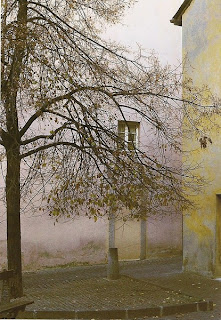It has been three years since I wrote something about the accomplished and underrated French artist Marguerite Burnat-Provins (1872-1952). It may be that the years she lived in Switzerland that nourished her imagination have contributed to her low visibility, at least in retrospect.
A shorthand way to visualize the Alps-Rhone River region that straddles the border between France and Switzerland is to think of the locale in Le genou de Claire (Claire’s Knee), Eric Rohmer’s 1970 film shot in the environs of Annecy. Why do that? Because the remarkable and little-known Marguerite Burnat-Provins, a native of historic Arras in northern France, fell in love with the region; it marked her art as she marked her adopted home.
A shorthand way to visualize the Alps-Rhone River region that straddles the border between France and Switzerland is to think of the locale in Le genou de Claire (Claire’s Knee), Eric Rohmer’s 1970 film shot in the environs of Annecy. Why do that? Because the remarkable and little-known Marguerite Burnat-Provins, a native of historic Arras in northern France, fell in love with the region; it marked her art as she marked her adopted home.
Marguerite Provins first lived in Switzerland following her marriage in 1896 to Adolphe Burnat, an archtiect from Vevey. The couple were divorced in 1908 and, for a time, Marguerite returned to France.
Vevey, on the shore of Lake Geneva, has long been an auspicious location for fiction. Part of the novel Daisy Miller (1878), first international success for Henry James, was set there. Not only do two characters in Louisa May Alcott’s Little Women (1868) fall in love in Vevey, it is the place where Amy learns of the death of her beloved sister Beth. Alcott may have chosen Vevey because she met the man who served as model for Laurie there. Closer to our time, Anita Brooknet set her Booker-Prize winning novelHotel du Lac (1984) at one of the grand tourist hotels on Lake Geneva.
In 1898 the Swiss painter Ernest Bieler invited Burnat-Provins to his chalet in the village of Saviese, in the French-speaking canton of Valais, The area, known for its fruit farming and vineyards, and its people captivated Burnat-Provins. She spent several months there each year with a group of artists known as L'école de Savièse, that flourished from 1880 until the outbreak of World War I. The only French artist there, Burnat-Provins used the Art Nouveau style and the new expressionism to bear on her subjects.In Blackberries, she shapes the grape vines, not eschewing realism but reinterpreting to Parisian tastes. The artist opened her own shop A La Cruche Verte (at The Green Jug ) in 1904 to market her decorative works and books.
Two paintings by Burnat-Provins from 1900 display the broad range of her artistic interests. The Young Girl of Saviese, executed in a mixture of watercolor, crayon, and pastel, employs the art Nouveau style to bracket her portrait, appropriately, with panels of the flowers and grape vines of the Valais region. If you look closely you can see glints of blue in the hat ribbons that cvhannel the bright orange sky. It was shown at the 1900 Exposition Universelle in Paris.
Alternatively, in Old Woman from Rouet the artist uses oil paint in thick strokes of color in a way that evokes thoughts of Van Gogh. Again, the expressionist style but with tongue in cheek, she painted Jarimouche, or The Congested Nose, a token of the allergy season in lush farm country.
Alternatively, in Old Woman from Rouet the artist uses oil paint in thick strokes of color in a way that evokes thoughts of Van Gogh. Again, the expressionist style but with tongue in cheek, she painted Jarimouche, or The Congested Nose, a token of the allergy season in lush farm country.
A fanciful/decadent element that is apparent in such early works as Salamanders later metamorphosed into horrific hallucinations for the artist during the war when her family was endangered. Burnat-Provins would later say that the nightmarish creatures of her dream life came to her and "dictated" her paintings of them. "I endure them, cringe as I feel them coming, and cannot help drawing them." There is a hint here that hallucination may be one of the goads to her prodigious creativity.
Burnat-Provins married again, this time an engineer from Valais, Paul de Kalbermatten. For Paul, Marguerite wrote and illustrated Le Livre pour toi (A Book For You), one of her several successful books Together, they traveled to his projects in Syria, Lebanon, and Morocco.
Perhaps unsurprisingly, it fell to an outsider to see the need for the preservation of Swiss culture. Burnat-Provins founded the Ligue Pour La Beauté in 1905, to preserve Swiss architecture, as well as "la Suisse pittoresque." The Société that exists today is the direct descendant of that organization.
Marguerite Burnat-Proins died in 1952 at Grasse, in the Alps-Maritime, in her native France.
Images: unless otherwise noted, reproduced from Marguerite Burnat-Provins: De l'Art nouveau à l'art hallucinatoire..
1. carte postale - Place Marguerite Burnat-Provins - Sion,Switzerland, Association pour la sauvegarde de la cite historique et artistique de Sion.
2. Marguerite Burnat-Provins - Jeune fille Saviese (Young Girl from Saviese), 1900, Foundation Neumann, Lausanne.
3. Marguerite Burnat-Provins - Mures (Blackberries), ca. 1904.
4.. Marguerite Burnat-Provins - Vielle aux Rouet (Old Woman from Rouet), 1900.
5. Marguerite Burnat-Provins - Jarimouche, or The Congested Nose, 1913, Schweizer Kunst.
6. Marguerite Burnat-Provins - Composition aux Salamandres et perce-neige, 1898.
Marguerite Burnat-Provins - an untitled watercolor, 1904, Foundation Neumann, Gingins.
3. Marguerite Burnat-Provins - Mures (Blackberries), ca. 1904.
4.. Marguerite Burnat-Provins - Vielle aux Rouet (Old Woman from Rouet), 1900.
5. Marguerite Burnat-Provins - Jarimouche, or The Congested Nose, 1913, Schweizer Kunst.
6. Marguerite Burnat-Provins - Composition aux Salamandres et perce-neige, 1898.
Marguerite Burnat-Provins - an untitled watercolor, 1904, Foundation Neumann, Gingins.






